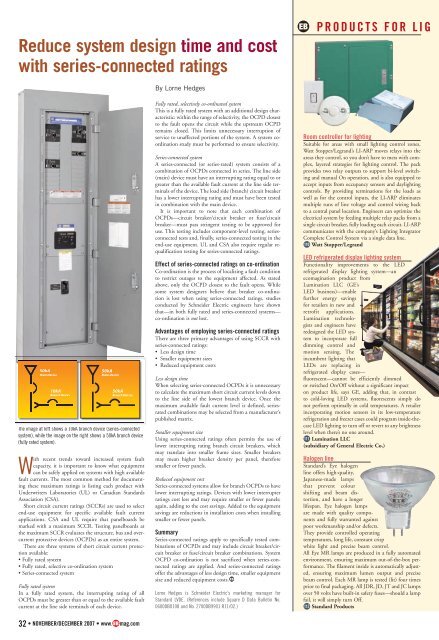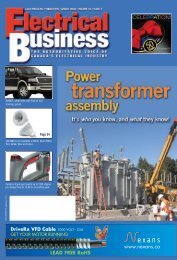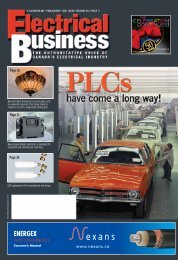Page 27 Page 32 Page 17 - Electrical Business Magazine
Page 27 Page 32 Page 17 - Electrical Business Magazine
Page 27 Page 32 Page 17 - Electrical Business Magazine
- No tags were found...
Create successful ePaper yourself
Turn your PDF publications into a flip-book with our unique Google optimized e-Paper software.
Reduce system design time and costwith series-connected ratingsPRODUCTS FOR LIGBy Lorne Hedges50kA50kAMain Main DeviceDevice10kA10kABranch Branch DeviceDevice50kA 50kAMain Main Device Device50kA 50kABranch Branch Device DeviceThe image at left shows a 10kA branch device (series-connectedsystem), while the image on the right shows a 50kA branch device(fully rated system).With recent trends toward increased system faultcapacity, it is important to know what equipmentcan be safely applied on systems with high availablefault currents. The most common method for documentingthese maximum ratings is listing each product withUnderwriters Laboratories (UL) or Canadian StandardsAssociation (CSA).Short circuit current ratings (SCCRs) are used to selectend-use equipment for specific available fault currentapplications. CSA and UL require that panelboards bemarked with a maximum SCCR. Testing panelboards atthe maximum SCCR evaluates the structure, bus and overcurrentprotective devices (OCPDs) as an entire system.There are three systems of short circuit current protectionavailable:• Fully rated system• Fully rated, selective co-ordination system• Series-connected systemFully rated systemIn a fully rated system, the interrupting rating of allOCPDs must be greater than or equal to the available faultcurrent at the line side terminals of each device.Fully rated, selectively co-ordinated systemThis is a fully rated system with an additional design characteristic:within the range of selectivity, the OCPD closestto the fault opens the circuit while the upstream OCPDremains closed. This limits unnecessary interruption ofservice to unaffected portions of the system. A system coordinationstudy must be performed to ensure selectivity.Series-connected systemA series-connected (or series-rated) system consists of acombination of OCPDs connected in series. The line side(main) device must have an interrupting rating equal to orgreater than the available fault current at the line side terminalsof the device. The load side (branch) circuit breakerhas a lower interrupting rating and must have been testedin combination with the main device.It is important to note that each combination ofOCPDs—circuit breaker/circuit breaker or fuse/circuitbreaker—must pass stringent testing to be approved foruse. This testing includes component-level testing, seriesconnectedtests and, finally, series-connected testing in theend-use equipment. UL and CSA also require regular requalificationtesting for series-connected ratings.Effect of series-connected ratings on co-ordinationCo-ordination is the process of localizing a fault conditionto restrict outages to the equipment affected. As statedabove, only the OCPD closest to the fault opens. Whilesome system designers believe that breaker co-ordinationis lost when using series-connected ratings, studiesconducted by Schneider Electric engineers have shownthat—in both fully rated and series-connected systems—co-ordination is not lost.Advantages of employing series-connected ratingsThere are three primary advantages of using SCCR withseries-connected ratings:• Less design time• Smaller equipment sizes• Reduced equipment costsLess design timeWhen selecting series-connected OCPDs it is unnecessaryto calculate the maximum short circuit current levels downto the line side of the lowest branch device. Once themaximum available fault current level is defined, seriesratedcombinations may be selected from a manufacturer’spublished matrix.Smaller equipment sizeUsing series-connected ratings often permits the use oflower interrupting rating branch circuit breakers, whichmay translate into smaller frame sizes. Smaller breakersmay mean higher breaker density per panel, thereforesmaller or fewer panels.Reduced equipment costSeries-connected systems allow for branch OCPDs to havelower interrupting ratings. Devices with lower interrupterratings cost less and may require smaller or fewer panels;again, adding to the cost savings. Added to the equipmentsavings are reductions in installation costs when installingsmaller or fewer panels.SummarySeries-connected ratings apply to specifically tested combinationsof OCPDs and may include circuit breaker/circuitbreaker or fuse/circuit breaker combinations. SystemOCPD co-ordination is not sacrificed when series-connectedratings are applied. And series-connected ratingsoffer the advantages of less design time, smaller equipmentsize and reduced equipment costs.Lorne Hedges is Schneider Electric’s marketing manager forStandard LVDE. (References include Square D Data Bulletin No.0600DB0108 and No. <strong>27</strong>00DB9901 R11/02.)Room controller for lightingSuitable for areas with small lighting control zones,Watt Stopper/Legrand’s LI-ARP moves relays into theareas they control, so you don’t have to mess with complex,layered strategies for lighting control. The packprovides two relay outputs to support bi-level switchingand manual On operation, and is also equipped toaccept inputs from occupancy sensors and daylightingcontrols. By providing terminations for the loads aswell as for the control inputs, the LI-ARP eliminatesmultiple runs of line voltage and control wiring backto a central panel location. Engineers can optimize theelectrical system by feeding multiple relay packs from asingle circuit breaker, fully loading each circuit. LI-ARPcommunicates with the company’s Lighting IntegratorComplete Control System via a single data line.110 Watt Stopper/LegrandLED refrigerated display lighting systemFunctionality improvements to the LEDrefrigerated display lighting system—anecomagination product fromLumination LLC (GE’sLED business)—enablefurther energy savingsfor retailers in new andretrofit applications.Lumination technologistsand engineers haveredesigned the LED systemto incorporate fulldimming control andmotion sensing. Theincumbent lighting thatLEDs are replacing inrefrigerated display cases—fluorescent—cannot be efficiently dimmedor switched On/Off without a significant impacton product life, says GE, adding that, in contrastto cold-loving LED systems, fluorescents simply donot perform optimally in cold temperatures. A retailerincorporating motion sensors in its low-temperaturerefrigeration and freezer cases could program inside-thecaseLED lighting to turn off or revert to any brightnesslevel when there’s no one around.111 Lumination LLC(subsidiary of General Electric Co.)Halogen lineStandard’s Eye halogenline offers high-quality,Japanese-made lampsthat prevent colourshifting and beam distortion,and have a longerlifespan. Eye halogen lampsare made with quality componentsand fully warranted againstpoor workmanship and/or defects.They provide controlled operatingtemperatures, long life, constant crispwhite light and precise beam control.All Eye MR lamps are produced in a fully automatedenvironment, ensuring maximum out-of-the-box performance.The filament inside is automatically adjusted,ensuring maximum lumen output and precisebeam control. Each MR lamp is tested (lit) four timesprior to final packaging. All JDR, JD, JT and JC lampsover 50 volts have built-in safety fuses—should a lampfail, it will simply turn Off.112 Standard Products<strong>32</strong> • NOVEMBER/DECEMBER 2007 • www. mag.com
















